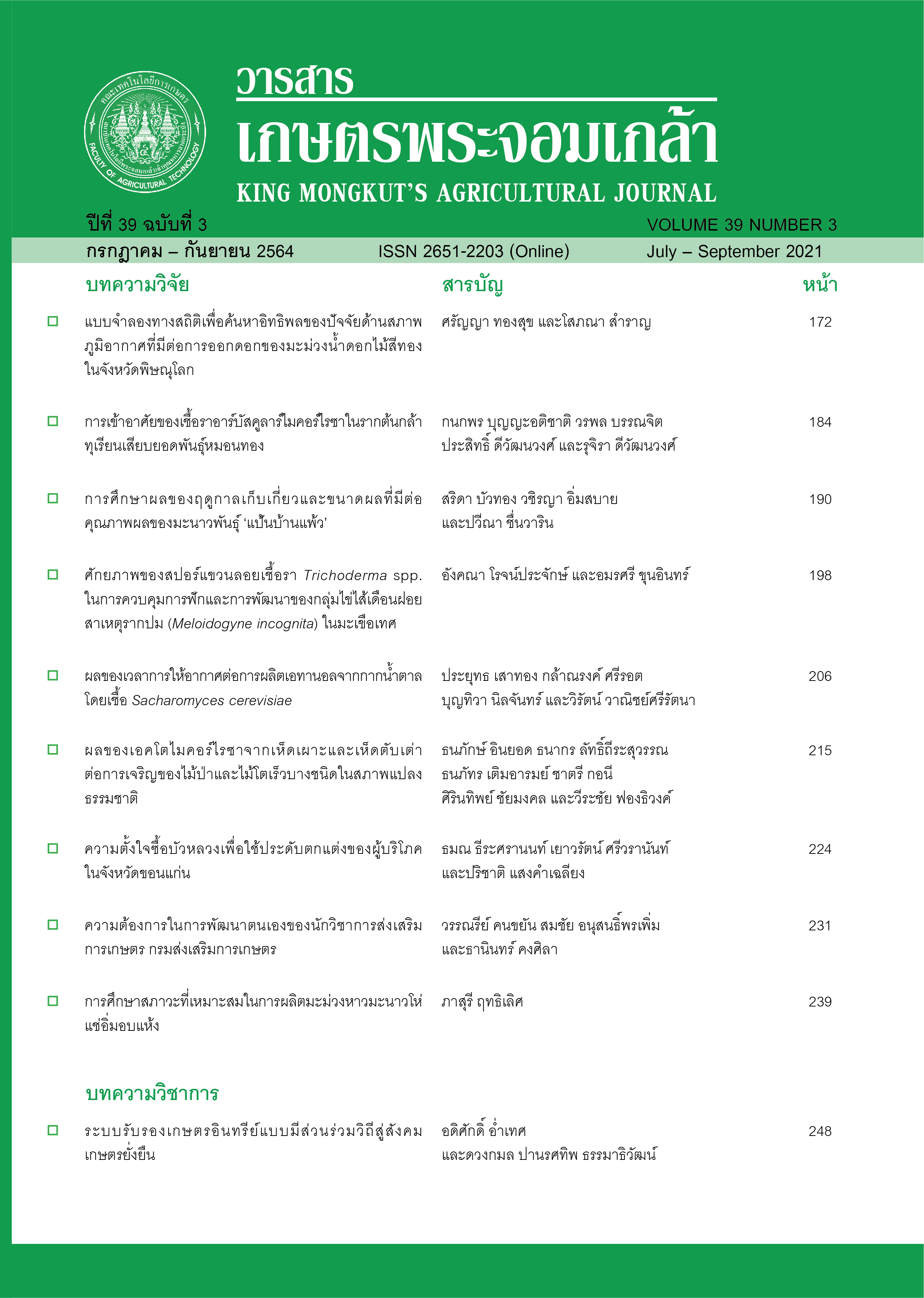A statistical model for finding the influence of weather factors on Thai Golden Honey mango flowering in Phitsanulok Province
Main Article Content
Abstract
A multiple regression model using factor analysis was used to predict the flowering of 'Namdokmai Sithong' mangoes in Phitsanulok province. Data concerned with the average number of flowerings per tree in eleven sample gardens in two sub-districts of Wang Thong district and three sub-districts of Noen Maprang district, and climate data for the same area including average temperature, average air pressure, average relative. humidity, and average rainfall were collected over two periods: February to March 2017 and September to December 2018. The data were applied to determine a multiple regression model based on Principal Component Analysis (PCA). The results showed that y ^ =21.623913-0.542305FS 1 -8.285513FS 2was the predictive equation or regression equation for the average number of flowerings/tree. From the equation, the average number of flowerings/tree increased when the first weather factor and the second weather factor decreased. This implied that climate was an important factor influencing the average number of flowerings/tree. It also suggested climate factors 1 and 2 could account for the 48.5 percent variation in the mean number of flowerings/plant. Furthermore, the researchers created a website, http://www.mangoforecast.com/ which can be used to predict the average number of flowerings/tree and to collect climate data from interested farmers. The data will be used to improve the forecasting equation for the average number of flowerings/tree and to achieve greater accuracy. In addition, the data will be used to determine the optimal climate factors influencing flowering in present and future Phitsanulok province.
Article Details
King Mongkut's Agricultural Journal
References
กัลยา วานิชย์บัญชา. 2559. การวิเคราะห์สถิติขั้นสูงด้วย SPSS for Windows. พิมพ์ครั้งที่ . กรุงเทพฯ: สามลดา.
จิรวรรณ โรจนพรทิพย์. 2558. เทคนิคการปลูกมะม่วงน้ำดอกไม้แบบมืออาชีพที่พิษณุโลก. https://www.facebook.com/smartfarmthailand/posts/231205270387951/. (9 เมษายน 2562).
ธัญลักษณ์ ตาสุข, พงศ์พันธุ์ เธียรหิรัญ และสัจจา บรรจงศิริ. 2556. การจัดการการผลิตมะม่วงนํ้าดอกไม้ของเกษตรกรในอำเภอวังทอง จังหวัดพิษณุโลก. ใน รายงานการประชุมเสนอผลงานวิจัยระดับบัณฑิตศึกษา มหาวิทยาลัยสุโขทัยธรรมาธิราช ครั้งที่ 4. น. 1-9. มหาวิทยาลัยสุโขทัยธรรมาธิราช, กรุงเทพฯ.
ประวิทย์ จันทร์แฉ่ง. 2553. การวิเคราะห์ความเสี่ยงต่อความแห้งแล้งในพื้นที่อำเภอกำแพงแสน จังหวัดนครปฐม โดยการประยุกต์ใช้ระบบสารสนเทศภูมิศาสตร์. วิทยานิพนธ์วิทยาศาสตรมหาบัณฑิต, การจัดการสิ่งแวดล้อม คณะพัฒนาสังคมและสิ่งแวดล้อม
มหาวิทยาลัยบัณฑิตพัฒนบริหารศาสตร์.
ปิยะดา วชิระวงศกร, สุภาวดี น้อยน้ำใส และทองใส จำนงการ. 2562. คัมภีร์การปลูกมะม่วงน้ำดอกไม้สีทอง. พิมพ์ครั้งที่ 1.
กรุงเทพฯ: โอ.เอส. พริ้นติ้ง เฮ้าส์.
วรางคณา กีรติวิบูลย์. 2558. การพยากรณ์ปริมาณน้ำฝน อำเภอเมือง จังหวัดน่าน. วารสารวิจัยและพัฒนา มจธ 38(3): 211-223.
ศุทธินี คุ้มครองทรัพย์. 2555. การสร้างตัวแบบการถดถอยเพื่อพยากรณ์ค่าความเข้มข้นของ NO2 ในจังหวัดชลบุรี.
ปัญหาพิเศษวิทยาศาสตรบัณฑิต, สาขาวิชาสถิติ คณะวิทยาศาสตร์ มหาวิทยาลัยบูรพา.
สำนักงานเศรษฐกิจการเกษตร กรมวิชาการเกษตร. 2558. https://www.facebook.com/supergreen999capsule/posts998446123596051/.
(9 เมษายน 2562).
สุจิตตรา สาระคนธ์, จรัสศรี รุ่งรัตนาอุบล และอนามัย นาอุดม. 2558. การปรับปรุงตัวแบบพยากรณ์ผลผลิตข้าวในเขตภาคเหนือตอนล่าง
ของประเทศไทย. ใน รายงานการประชุมทางวิชาการระดับชาติด้านคอมพิวเตอร์และเทคโนโลยีสารสนเทศ ครั้งที่ 11. น. 31-36. มหาวิทยาลัยเทคโนโลยีพระจอมเกล้าพระนครเหนือ, กรุงเทพฯ.
อรนงค์ บุเกตุ และพุธษดี ศิริแสงตระกูล. 2556. แบบจำลองการพยากรณ์ปริมาณอ้อยของภาคตะวันออกเฉียงเหนือ โดยการใช้โครงข่ายประสาทเทียม. วารสารวิทยาศาสตร์ มหาวิทยาลัยขอนแก่น 41(1): 213-225.
อานนท์ สนิทวงศ์ ณ อยุธยา. 2554. รายงานการสังเคราะห์และประมาณสถานภาพองค์ความรู้ ด้านการเปลี่ยนแปลงภูมิอากาศของไทย
พ.ศ. 2554 คณะทำงานกลุ่มที่ 2 องค์ความรู้ ด้านผลกระทบความล่อแหลมและการปรับตัว. บัณฑิตวิทยาลัยร่วมด้านพลังงานและ สิ่งแวดล้อม มหาวิทยาลัยเทคโนโลยีพระจอมเกล้าธนบุรี, กรุงเทพฯ.
Baayen, R. H. 2016. Analyzing linguistic data: A practical introduction to statistics. https://www.researchgate.net/publication/
_Analyzing_Linguistic_Data_A_practical_introduction_to_statistics_using_R. (8 April 2019).
Mehmet, M. 2011. Multivariate multiple regression analysis based on principal component score to study relationships between
some pre- and post-slaughter traits of broilers. Journal of Agricultural Science 17: 77-83.
Mendes, M. 2009. Multiple linear regression models based on principal component scores to predict slaughter weight of broiler. Archiv fur Geflugelkunde 73(2): 139-144.
Rakshitha, M., Shivananda, T. N., and Shivananda, A. 2016. Weather based forecasting models for prediction of leafhopper population Idioscopus nitidulus Walker; (Hemiptera: Cicadellidae) in mango orchard. Journal of Entomology and Zoology Studies 5(1): 163-168.
Kaundal, R., Kapoor, A. S., and Raghava, G. P. S. 2006. Machine learning techniques in disease forecasting: A case study on
rice blast prediction. BMC Bioinformatics 7(485): 1-16.
Rathod, S., and Mishra, G. C. 2017. Weather based modeling for forecasting area and production of mango in Karnataka. International Journal of Agriculture, Environment and Biotechnology 10(1): 149-162.
Statistical Consulting Staff. 2019. Practical introduction to factor analysis: Exploratory factor analysis. University of California
(Los Angeles) Institute for Digital Research & Education.https://stats.idre.ucla.edu/spss/seminars/introduction-to-factor-analysis/a-practical-introduction-to-factor-analysis/ (9 April 2019).
Venugopalan, R., Rawal, R. D., and Saxena, A. K. 2006. A statistical model for ascertaining the influence and reliability of weather parameters on incidence of blossom blight in mango (Mangifera indica L.). Journal of Horticultural Science 1(1): 64-67.


